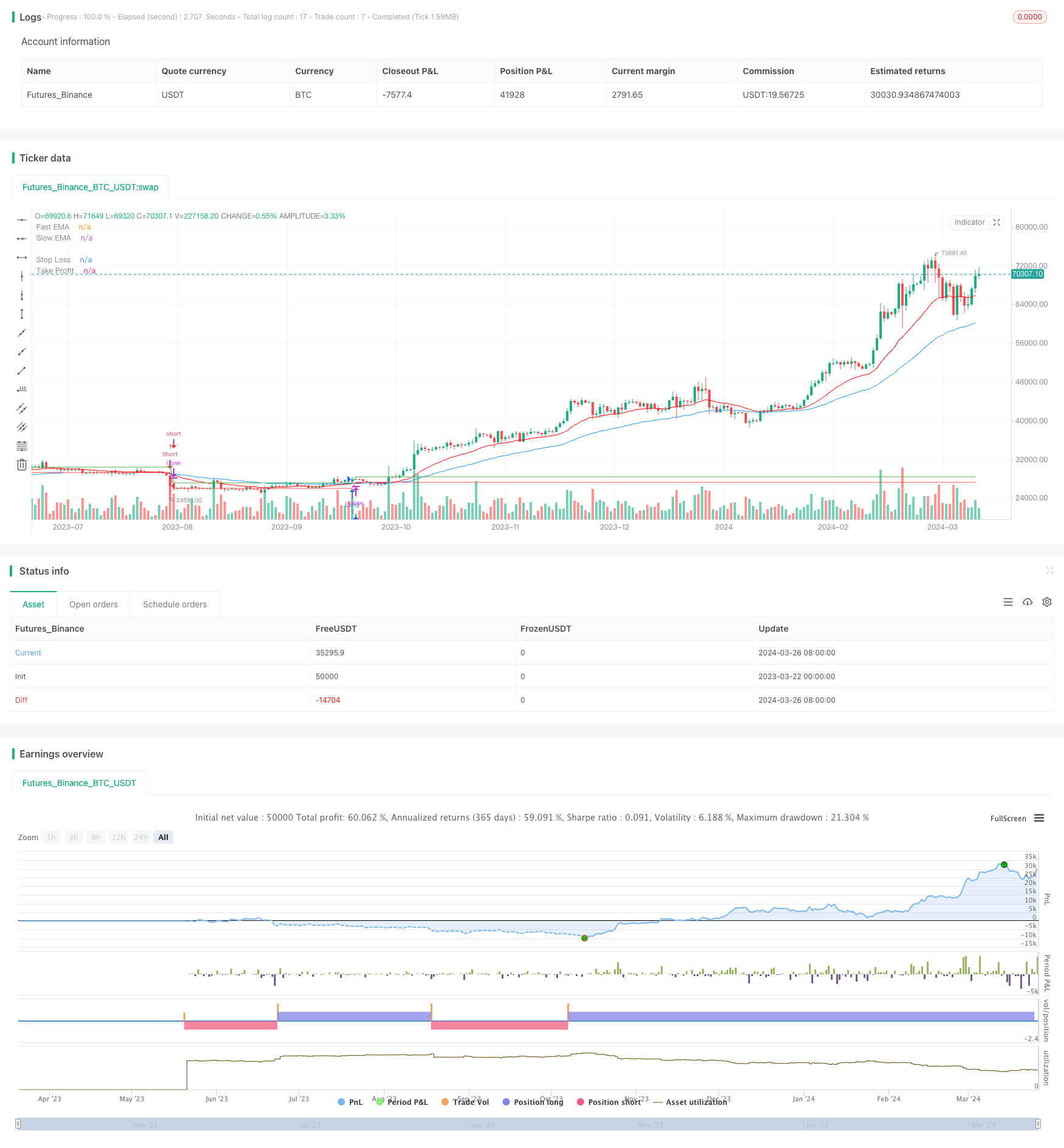
概述
该策略是一个基于快速和慢速指数移动平均线(EMA)交叉的交易策略。当快速EMA从下向上穿过慢速EMA时,策略会进行做多交易;当快速EMA从上向下穿过慢速EMA时,策略会进行做空交易。该策略使用目标止损比例来计算止损和止盈价格,并使用固定的仓位大小进行交易。
策略原理
该策略的主要原理是利用两条不同周期的EMA来捕捉价格趋势的变化。当快速EMA与慢速EMA发生交叉时,通常意味着价格趋势发生了变化。具体来说,当快速EMA从下向上穿过慢速EMA时,表明价格可能开始上涨趋势,此时策略会进行做多交易;当快速EMA从上向下穿过慢速EMA时,表明价格可能开始下跌趋势,此时策略会进行做空交易。
该策略还引入了目标止损比例的概念,用于计算每笔交易的止损和止盈价格。止损价格是通过将平均开仓价格乘以(1 - 目标止损比例)得到,而止盈价格是通过将平均开仓价格乘以(1 + 目标止损比例)得到。这种方法可以根据风险偏好动态调整止损和止盈水平。
此外,该策略采用固定仓位大小的方式进行交易,即每笔交易的资金量是固定的,不会根据账户余额或其他因素进行调整。这有助于控制风险和保持策略的一致性。
策略优势
简单有效:该策略基于经典的EMA交叉原理,易于理解和实现,同时能够有效捕捉价格趋势的变化。
动态止损止盈:通过引入目标止损比例,策略可以根据风险偏好动态调整止损和止盈水平,提高了策略的灵活性和适应性。
风险控制:采用固定仓位大小的方式进行交易,有助于控制每笔交易的风险敞口,降低了账户的整体风险。
适用性广:该策略可以应用于各种金融市场和交易品种,如股票、期货、外汇等,具有广泛的适用性。
策略风险
参数敏感性:该策略的表现依赖于EMA的参数选择,如快速EMA和慢速EMA的周期。不同的参数组合可能导致策略表现差异较大,因此需要仔细优化和测试参数。
欠优化风险:如果策略参数过度优化,可能导致策略在样本外数据上表现不佳,即出现过拟合问题。因此,需要对策略进行全面的回测和前瞻性测试,以确保其稳健性。
市场风险:该策略的表现受到市场趋势和波动的影响。在震荡市或趋势不明朗时,策略可能会产生较多的错误信号,导致频繁交易和资金损失。
黑天鹅事件:该策略对极端市场事件(如金融危机、地缘政治冲突等)的适应性可能较差,这些事件可能导致策略出现较大回撤。
策略优化方向
动态参数优化:考虑根据市场状态或价格波动特征,动态调整EMA的周期参数,以适应不同的市场环境。这可以通过引入市场状态判断指标或波动率指标来实现。
信号过滤:在EMA交叉信号的基础上,引入其他技术指标或市场信息对信号进行过滤,以提高信号的可靠性和准确性。例如,可以结合成交量、动量指标或市场情绪指标等。
仓位管理优化:考虑根据市场风险状况或个人风险偏好,动态调整交易仓位大小,而不是使用固定仓位。这可以通过引入风险控制模型或资金管理规则来实现。
多空对冲:可以考虑同时持有多头和空头头寸,构建市场中性组合,以降低市场风险和提高策略稳定性。
总结
该策略是一个基于EMA交叉原理的趋势追踪策略,通过引入目标止损比例和固定仓位大小的机制,在控制风险的同时捕捉价格趋势。策略的优势在于简单有效、动态止损止盈和广泛适用性,但同时也面临参数敏感性、欠优化风险和市场风险等挑战。未来可以从动态参数优化、信号过滤、仓位管理优化和多空对冲等方面对策略进行改进和完善,以提升其稳健性和盈利能力。
/*backtest
start: 2023-03-22 00:00:00
end: 2024-03-27 00:00:00
period: 1d
basePeriod: 1h
exchanges: [{"eid":"Futures_Binance","currency":"BTC_USDT"}]
*/
// This Pine Script™ code is subject to the terms of the Mozilla Public License 2.0 at https://mozilla.org/MPL/2.0/
// © KarthicSRSivagnanam
//@version=5
strategy("EMA Crossover Strategy with Target/Stop-loss Ratio and Fixed Position Size", shorttitle="EMA Cross", overlay=true)
// Define input variables
fast_length = input(20, title="Fast EMA Length")
slow_length = input(50, title="Slow EMA Length")
ema_color = input(color.red, title="EMA Color")
target_ratio = input(2, title="Target/Stop-loss Ratio")
position_size = input(1, title="Fixed Position Size (Rs.)")
// Calculate EMAs
ema_fast = ta.ema(close, fast_length)
ema_slow = ta.ema(close, slow_length)
// Plot EMAs
plot(ema_fast, color=ema_color, title="Fast EMA")
plot(ema_slow, color=color.blue, title="Slow EMA")
// Long entry condition: Fast EMA crosses above Slow EMA
longCondition = ta.crossover(ema_fast, ema_slow)
// Short entry condition: Fast EMA crosses below Slow EMA
shortCondition = ta.crossunder(ema_fast, ema_slow)
// Calculate stop-loss and target levels
stopLoss = strategy.position_avg_price * (1 - target_ratio / 100)
takeProfit = strategy.position_avg_price * (1 + target_ratio / 100)
// Plot stop-loss and target levels
plot(stopLoss, color=color.red, title="Stop Loss")
plot(takeProfit, color=color.green, title="Take Profit")
// Entry conditions with fixed position size
if (longCondition)
strategy.entry("Long", strategy.long, qty = position_size)
if (shortCondition)
strategy.entry("Short", strategy.short, qty = position_size)
// Plot entry signals
plotshape(series=longCondition, title="Buy Signal", location=location.belowbar, color=color.green, style=shape.triangleup, size=size.small)
plotshape(series=shortCondition, title="Sell Signal", location=location.abovebar, color=color.red, style=shape.triangledown, size=size.small)